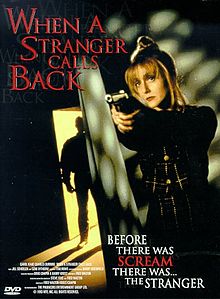“It’s Dark Now. I Can’t See.”
Fourteen years after director Fred Walton’s When A Stranger Calls (1979) scared audiences into hysterics, a little-known sequel hit the airwaves as a made-for-TV movie. When A Stranger Calls Back (1993) is the follow up to the famous original from the golden era of American horror. The sequel brought Fred Walton back into the director’s chair, reinstated Carol Kane’s role as Jill Johnson, and recalled Charles Durning as John Clifford. Jill Schoelen played Julia Jenz, a college student being terrorized by an unstable (and impossible to catch) stalker.
You are probably thinking, How can a made-for-TV movie possibly deliver the immense dread of the original? To this argument, I present Salem’s Lot (1979), the TV miniseries based on Stephen King’s classic vampire novel which scared the daylights out of a nation of horror fans. Made-for-TV does not necessarily mean dull. Also consider that When A Stranger Calls was not at all gory. Walton’s classic use of pacing, camera angles, and music, combined with a water-tight script and the star power and acting prowess of Carol Kane, infused a sense of dread in the original. Walton brought all of these tools and more to the TV sequel.
The first twenty minutes of When A Stranger Calls are considered by many horror fans to be the best in the genre’s history. It seems impossible to conceive Walton could make the opening scene of When A Stranger Calls Back just as terrifying, but that is exactly what he did. The beginning of the sequel follows Julia, who, like Jill Johnson fourteen years ago, is babysitting in a large house in a secluded area. An unseen man knocks on the front door late at night, claiming he’s experiencing car trouble and needs to use the phone. Petrified, Julia will not let him inside. And when she checks the phone, she finds the line is dead. You can guess what happens next.
When Julia returns to college, she senses she isn’t alone in her tiny apartment, even though there are few places for someone to hide. She bolts her door before sleep, only to find upon awakening that personal items have been moved – a picture relocated to a different shelf, etc. These subtle, tortuous acts are perpetrated to disturb Julia, while providing her with no hard evidence to bring to the police. When she approaches the authorities, they write her off, thinking she is mistaken and under stress. Only Jill Johnson, now a counselor at Julia’s college, believes Julia’s story. Jill brings John Clifford back into the fold, and together they unravel the mystery of how the stalker slips in and out of Julia’s apartment without being seen. I won’t give away the big reveal, but it is a shocker. Some fans found it a little too unbelievable, but I thought it was a great touch. I’ll let you decide for yourself.
There is a significant difference between the original and the sequel. The original allowed its three acts to cross genres – the first and third acts are pure psychological horror, whereas the second act is more of a detective story in which Clifford attempts to apprehend the murderer. Some fans were put off by the second act. In the sequel, Walton keeps to psychological horror from start to finish. Hence, the finished product is as relentless as it is frightening.
However, “When a Stranger Calls Back” does suffer from some pacing issues, especially in the middle act, and there are moments where it feels constrained by its television origins, both in terms of content and production quality. Some subplots and character decisions may leave viewers scratching their heads, and not every twist lands with the impact it aims for.
Yet, it’s the performances that elevate the film. Carol Kane’s portrayal of a woman still haunted by her past is both heartbreaking and compelling. Jill Schoelen, as Julia, manages to evoke genuine sympathy, making her plight relatable and ensuring the audience roots for her.

The Ingenious Twist in “When a Stranger Calls Back”
Warning: Spoiler Alert!
The climax of “When a Stranger Calls Back” offers an unexpected twist that, in many ways, redefines the suspense-building of the entire narrative. The revelation that the stalker, the antagonist causing such trauma and fear throughout the film, was hiding inside Julia’s room is a masterstroke in horror storytelling. He achieves this chilling presence by using body paint and the art of camouflage, essentially blending into the wall. This inventive method of infiltration is a brilliant display of the lengths to which the antagonist goes to psychologically torment his victims, bringing the terror right into the intimate sanctity of a personal space, making nowhere seem safe.
However, like all cinematic twists, it comes with its share of pros and cons. On the positive side, this unexpected method of evasion is genuinely unsettling. It taps into a primal fear many people have about intruders— the idea that a threat might be closer than one thinks, hiding in plain sight. The twist also pays homage to the original’s theme of threats lurking close by, echoing the famous line, “The call is coming from inside the house.” On the downside, some viewers might find the premise slightly far-fetched. The logistics of remaining motionless and perfectly blended into the wall, avoiding detection during the day-to-day activities in the room, stretch believability. It may also prompt questions about the viability of this method over an extended period and could pull some viewers out of the immersive experience, leading them to question the practicalities rather than suspending disbelief.
If you are searching for a true hidden horror gem, “When A Stranger Calls Back” is worth the effort to track down. As of this review, Amazon still has copies of “When A Stranger Calls Back”. Get it before it goes out of print. You won’t be disappointed.

